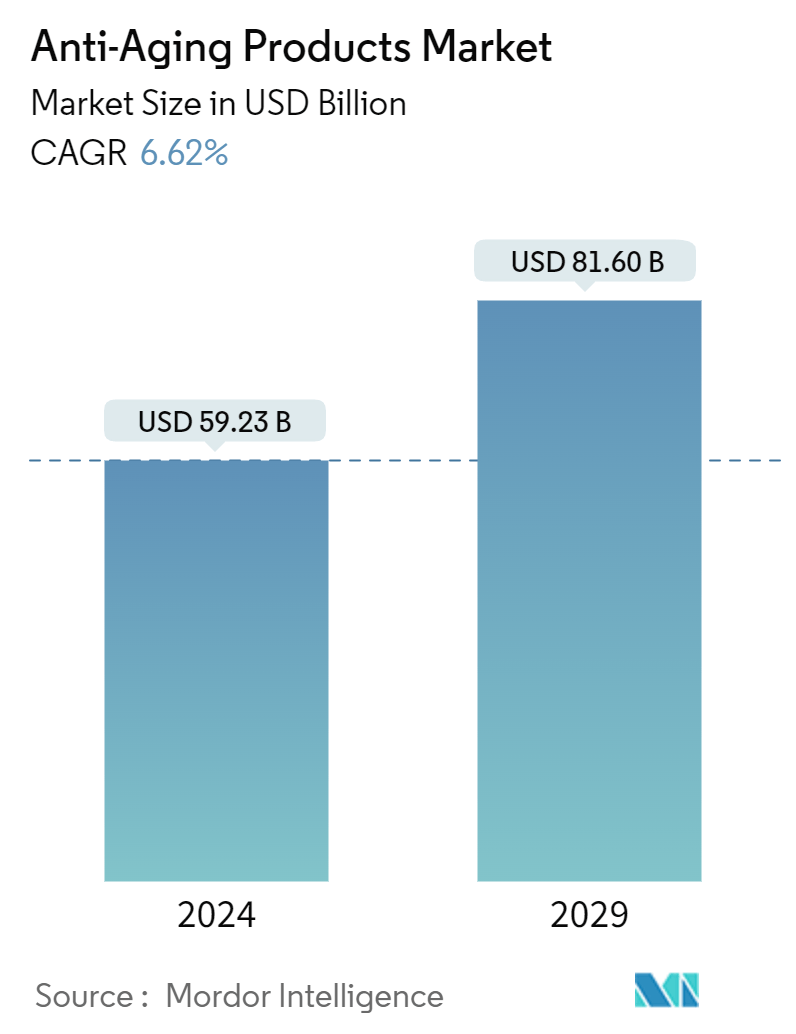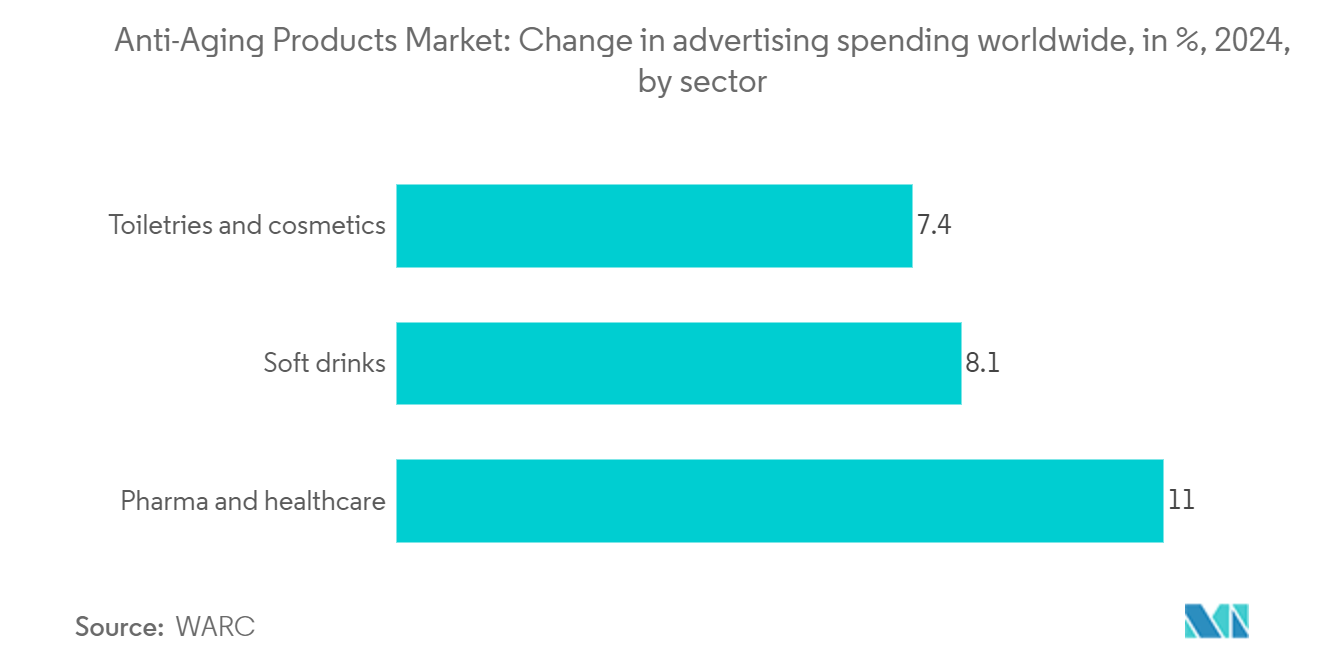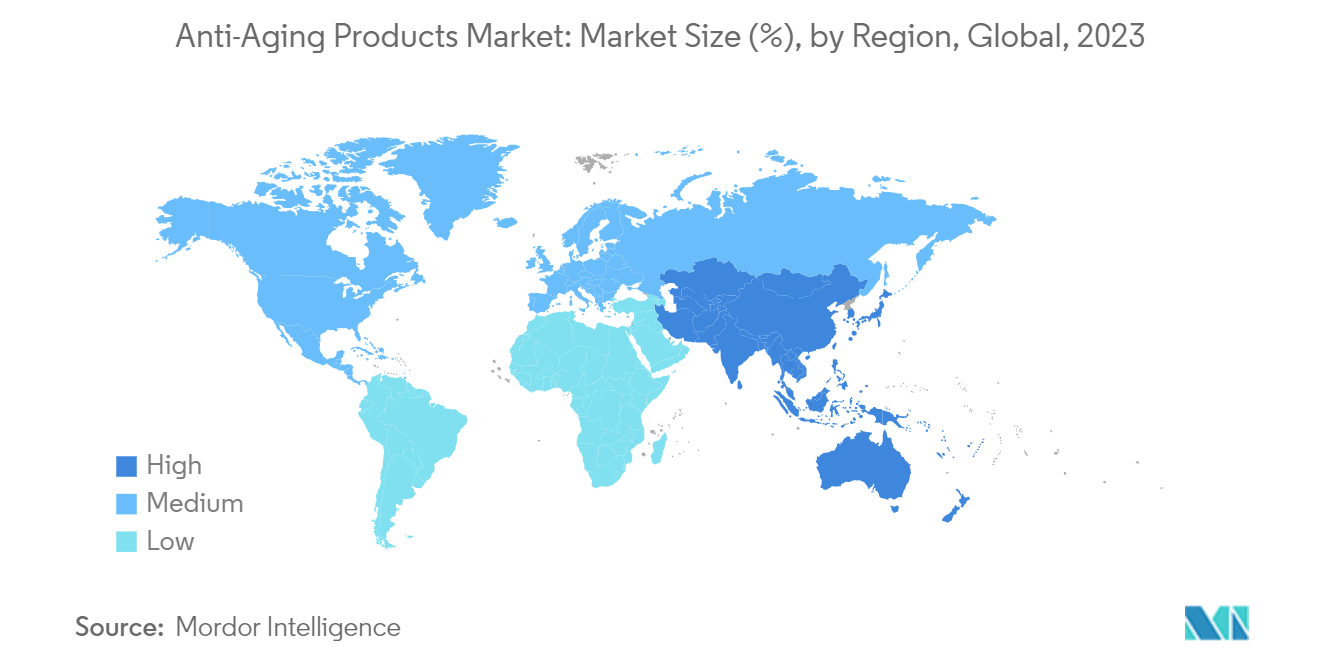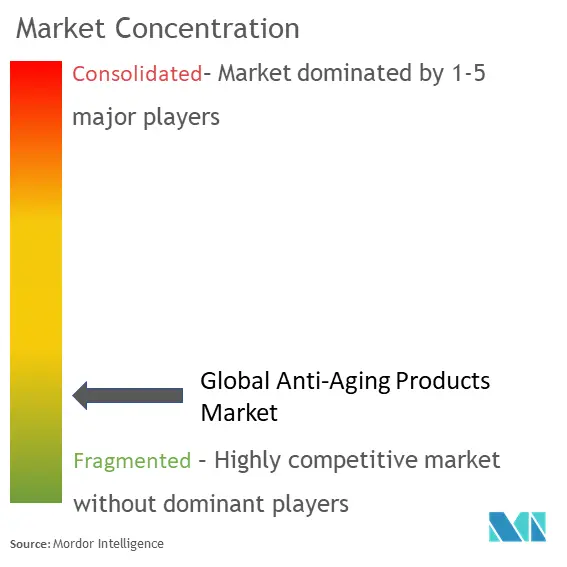Anti-Aging Products Market Size

| Study Period | 2019 - 2029 |
| Market Size (2024) | USD 59.23 Billion |
| Market Size (2029) | USD 81.60 Billion |
| CAGR (2024 - 2029) | 6.62 % |
| Fastest Growing Market | Asia Pacific |
| Largest Market | Asia Pacific |
Major Players.webp)
*Disclaimer: Major Players sorted in no particular order |
Need a report that reflects how COVID-19 has impacted this market and its growth?
Anti-Aging Products Market Analysis
The Anti-Aging Products Market size is estimated at USD 59.23 billion in 2024, and is expected to reach USD 81.60 billion by 2029, growing at a CAGR of 6.62% during the forecast period (2024-2029).
The rising demand for anti-aging products can be attributed to growing skin concerns among consumers, such as wrinkles, fine lines, and dry skin. For instance, according to an article published by the British Skin Foundation in 2023, approximately 60% of people in the United Kingdom have had or currently have some skin condition. Therefore, with a rising focus on personal grooming, consumers increasingly prefer skincare products that claim to focus on the specific needs of anti-aging. Besides this, the desire for youthful skin, especially among the aging population, drives the demand for preventive anti-aging solutions. Moreover, the increasing demand for multi-functional skincare products, such as anti-wrinkle creams, drives the market. Manufacturers also offer products with free-from claims, such as vegan, paraben-free, and sulfate-free, to cater to the demands for natural and organic products. For instance, in May 2022, Shiseido launched its conscious skincare brand, Ulé, in France. The company offers anti-aging skincare products such as serums and creams. The company also claimed the products to be vegan and cruelty-free, consisting of around 96% natural-origin ingredients.
Anti-Aging Products Market Trends
Aggressive Marketing and Advertising By Brands
With the proliferation of online resources, including skincare blogs, tutorials, and product reviews, young individuals can easily access information about skin ingredients, routines, and treatments. This empowers them to make informed purchase choices. Therefore, expenditure on marketing and advertisement is pivotal in expanding the market by strongly impacting consumer preferences and purchasing behavior. One of the prominent strategies that several brands follow is influencer marketing, where companies collaborate with celebrities and social media influencers to attract consumers’ attention and enhance their preferences and confidence while choosing products. For instance, in January 2023, L’Oréal Paris introduced a mature creator-led campaign to promote the launch of Age Perfect Golden Age Rosy-Oil Serum, a revitalizing oil serum for mature skin. The company collaborated with ten influencers aged 45 and over; the eldest featured influencer in the campaign was an Instagram celebrity, Lady Silver, who is 84 years old. Others were 65-year-old blogger and model Susanne Histrup and Finnish entrepreneur and author Merja Mähkä.

Asia Pacific To Lead The Market
The growth of anti-aging products in Asian countries, including China, Japan, Singapore, India, and Australia, is increasing significantly. Consumers seek skincare products with blended formulations and pure organics to provide healthy fixes for dry and damaged skin. Also, in terms of distribution channels, online store sales for personal care products are growing faster, attracting many vertical specialists like Amazon, Walmart, and Flipkart, who are riding on increasing their e-retailing growth and vying for a significant pie in the online retail space.
The rapidly aging population in China fuels the demand for a wide range of anti-aging products, including skincare, supplements, and cosmetic procedures. According to the National Bureau of Statistics in China, approximately 8.09%, 7.61%, 6.81%, and 7.2% were aged between 30-34, 35-39, 40-44, and 45-49 years, respectively. Moreover, Japan has been witnessing a rise in demand for functional anti-aging products, prompting manufacturers to research, formulate, and launch products with additional functionalities. For instance, in September 2023, Rohto Pharmaceutical Co. Ltd, headquartered in Osaka City, Japan launched Bloomio. This new dimension skincare brand was claimed to approach the root causes of aging signs, addressing the skin changes that occur with age. The company developed Rohto's unique functional ingredient, “Blue Ceramide," and incorporated it into their cosmetics. The aging care brand “Bloomio,” which utilized knowledge from past dermatological research, was released at specific stores such as drugstores and variety shops and on EC sites across Japan.

Anti-Aging Products Industry Overview
The global anti-aging products market is highly competitive, with the presence of several regional and international players. The market is dominated by players such as Beiersdorf Limited, L’Oreal, Procter & Gamble, The Estée Lauder Companies Inc., and Unilever PLC. The primary strategy adopted by the leading companies to attract the largest share of consumers is introducing new products, allowing consumers to choose from a wide range of products specifically suited to their skin types. Other strategies adopted by the leading players include partnerships and mergers to expand their consumer reach and production capacity.
Anti-Aging Products Market Leaders
Beiersdorf Limited
The Estée Lauder Companies Inc.
Procter & Gamble
L’Oreal SA
Unilever PLC
*Disclaimer: Major Players sorted in no particular order

Anti-Aging Products Market News
- April 2024: Nivea expanded its anti-aging product portfolio by launching the Q10 Dual Action serum. The company claims that the serum targets sugar-induced skin aging and wrinkle formation. The formula was designed to prevent protein glycation in the dermis skin layer, protecting collagen and elastin from damage.
- March 2024: L'Oréal Canada launched SkinBetter Science, a medical aesthetic skincare brand, adding it to the L'Oréal Dermatological Beauty (LDB) division. The brand claimed that SkinBetter Science is currently distributed across Canada and on the www.skinbetter.ca website.
- March 2024: Dermalogica launched its new product - Circular Hydration Serum. The product comprises hyaluronic acid and algae extracts, forming a moisturizing matrix that delivers rapid and enduring hydration. This dynamic combination forms a protective barrier, safeguarding skin against moisture loss.
Anti-Aging Products Market Report - Table of Contents
1. INTRODUCTION
2. RESEARCH METHODOLOGY
3. EXECUTIVE SUMMARY
4. MARKET DYNAMICS
4.1 Market Drivers
4.1.1 Aggressive Marketing and Advertising By Brands
4.1.2 Desire Among Consumers For Youthful Skin
4.2 Market Restraints
4.2.1 Availability of Counterfeit Products
4.3 Porter's Five Forces Analysis
4.3.1 Threat of New Entrants
4.3.2 Bargaining Power of Buyers/Consumers
4.3.3 Bargaining Power of Suppliers
4.3.4 Threat of Substitute Products
4.3.5 Intensity of Competitive Rivalry
5. MARKET SEGMENTATION
5.1 By Product Type
5.1.1 Facial Creams and Lotions
5.1.2 Serums and Concentrates
5.1.3 Under Eye Creams
5.1.4 Others (Facial Oils, Sheet Masks)
5.2 By Distribution Channel
5.2.1 Supermarkets/Hypermarkets
5.2.2 Specialty Stores
5.2.3 Pharmacies/Drug Stores
5.2.4 Online Retail Stores
5.2.5 Other Distribution Channels
5.3 Geography
5.3.1 North America
5.3.1.1 United States
5.3.1.2 Canada
5.3.1.3 Mexico
5.3.1.4 Rest of North America
5.3.2 Europe
5.3.2.1 Spain
5.3.2.2 United Kingdom
5.3.2.3 Germany
5.3.2.4 France
5.3.2.5 Italy
5.3.2.6 Russia
5.3.2.7 Rest of Europe
5.3.3 Asia Pacific
5.3.3.1 China
5.3.3.2 Japan
5.3.3.3 India
5.3.3.4 Australia
5.3.3.5 Rest of Asia-Pacific
5.3.4 South America
5.3.4.1 Brazil
5.3.4.2 Colombia
5.3.4.3 Rest of South America
5.3.5 Middle East and Africa
5.3.5.1 South Africa
5.3.5.2 Saudi Arabia
5.3.5.3 Rest of Middle East and Africa
6. COMPETITIVE LANDSCAPE
6.1 Most Adopted Strategies
6.2 Market Share Analysis
6.3 Company Profiles
6.3.1 Beiersdorf Limited
6.3.2 The Estee Lauder Companies Inc.
6.3.3 Procter & Gamble
6.3.4 LOreal SA
6.3.5 Oriflame Cosmetics AG
6.3.6 Naos Group (Bioderma Laboratories)
6.3.7 Shiseido Company Limited
6.3.8 Groupe Clarins
6.3.9 Caudalie
6.3.10 Natura & Co.
- *List Not Exhaustive
7. MARKET OPPORTUNITIES AND FUTURE TRENDS
Anti-Aging Products Industry Segmentation
Anti-aging products are cosmetics formulated to reduce the appearance of aging skin and promote a youthful appearance. They are often formulated to address the skin concerns that come with aging, including lines, wrinkles, uneven skin color, and firmness.
The global anti-aging products market is segmented by product type and distribution channel, By product type, the market is segmented into facial creams and lotions, serums and concentrates, under eye creams, and others. By distribution channel, the market is segmented into supermarkets/ hypermarkets, specialty stores, pharmacies/drug stores, online retail and other distribution channels. Further, the study covers the regional level analysis of North America, Europe, Asia-Pacific, South America, and the Middle East and Africa.
The market sizing has been done in value terms in USD for all the abovementioned segments.
| By Product Type | |
| Facial Creams and Lotions | |
| Serums and Concentrates | |
| Under Eye Creams | |
| Others (Facial Oils, Sheet Masks) |
| By Distribution Channel | |
| Supermarkets/Hypermarkets | |
| Specialty Stores | |
| Pharmacies/Drug Stores | |
| Online Retail Stores | |
| Other Distribution Channels |
| Geography | |||||||||
| |||||||||
| |||||||||
| |||||||||
| |||||||||
|
Anti-Aging Products Market Research FAQs
How big is the Anti-Aging Products Market?
The Anti-Aging Products Market size is expected to reach USD 59.23 billion in 2024 and grow at a CAGR of 6.62% to reach USD 81.60 billion by 2029.
What is the current Anti-Aging Products Market size?
In 2024, the Anti-Aging Products Market size is expected to reach USD 59.23 billion.
Who are the key players in Anti-Aging Products Market?
Beiersdorf Limited, The Estée Lauder Companies Inc., Procter & Gamble, L’Oreal SA and Unilever PLC are the major companies operating in the Anti-Aging Products Market.
Which is the fastest growing region in Anti-Aging Products Market?
Asia Pacific is estimated to grow at the highest CAGR over the forecast period (2024-2029).
Which region has the biggest share in Anti-Aging Products Market?
In 2024, the Asia Pacific accounts for the largest market share in Anti-Aging Products Market.
What years does this Anti-Aging Products Market cover, and what was the market size in 2023?
In 2023, the Anti-Aging Products Market size was estimated at USD 55.31 billion. The report covers the Anti-Aging Products Market historical market size for years: 2019, 2020, 2021, 2022 and 2023. The report also forecasts the Anti-Aging Products Market size for years: 2024, 2025, 2026, 2027, 2028 and 2029.
Anti-Aging Products Industry Report
Statistics for the 2024 Anti-Aging products market share, size and revenue growth rate, created by Mordor Intelligence™ Industry Reports. Anti-Aging products analysis includes a market forecast outlook to 2029 and historical overview. Get a sample of this industry analysis as a free report PDF download.
